THE IMPACT ON NATURE
Interviews with scientists
The Białowieża Forest, located on the Polish-Belarusian border, was inscribed on the UNESCO World Heritage List, which made it a common good of humanity. Initially, only the Polish part of the area was inscribed on the World Heritage List in 1979. The Belarusian part of the Białowieża Forest was added in 1992, which makes both parts of the Forest a single cross-border facility. The inscribed area covers an area of 141,885 hectares. From the point of view of preserving biodiversity, this place is unique.
The Białowieża Primeval Forest contains the best-preserved fragments of lowland deciduous and mixed forests in the European Plain, in which, in a large area (also outside the national park and nature reserves), natural processes, undisturbed by direct human intervention, take place, covering all stages of the dynamics of the forest ecosystem. The largest population of the European bison, a species that has become a symbol of this region, is found here, as well as many very rare species, such as the three-toed woodpecker, the cinnabar crusher and the pygmy owl. Various types of scientific research have been carried out in the area of the Forest for decades, precisely because of its uniqueness and the possibility of observing natural processes. There are such institutions as the Institute of Mammal Biology of the Polish Academy of Sciences, the Geobotanical Station of the University of Warsaw, the European Center for Natural Forests of the Forest Research Institute and the Research Laboratory of the Białowieża National Park. The research was also international in nature and there was close cooperation with the Belarusian side because a broad coverage of the entire facility of the Białowieża Forest on both sides of the border in the research was crucial for scientists.
In 2021, the migration crisis began on the Polish-Belarusian border and its consequences affect now and will probably affect the natural environment so valuable here for the next few years. The construction of the barrier was a huge investment, during which heavy equipment was used, various types of materials were transported, roads were widened and nature was devastated. Due to the increased traffic of vehicles, noise and other features accompanying the construction and transport, the processes natural for this area have been interrupted. Were possibilities of other solutions sought, or were specialists consulted? How were the effects of the investment mitigated? We also asked specialists from scientific institutions dealing with the Białowieża Forest on a daily basis in their scientific work what impact does the barrier have on nature and what may be the consequences of its erection in the coming years.
Text and photo above: Eliza Kowalczyk
Photo: The Bialowieza Forest, August 5, 2022
Interview with Katarzyna Nowak,
scientist at the Geobotanical Station in Bialowieza.
October 19, 2022
Interview by: Hanna Jarzabek
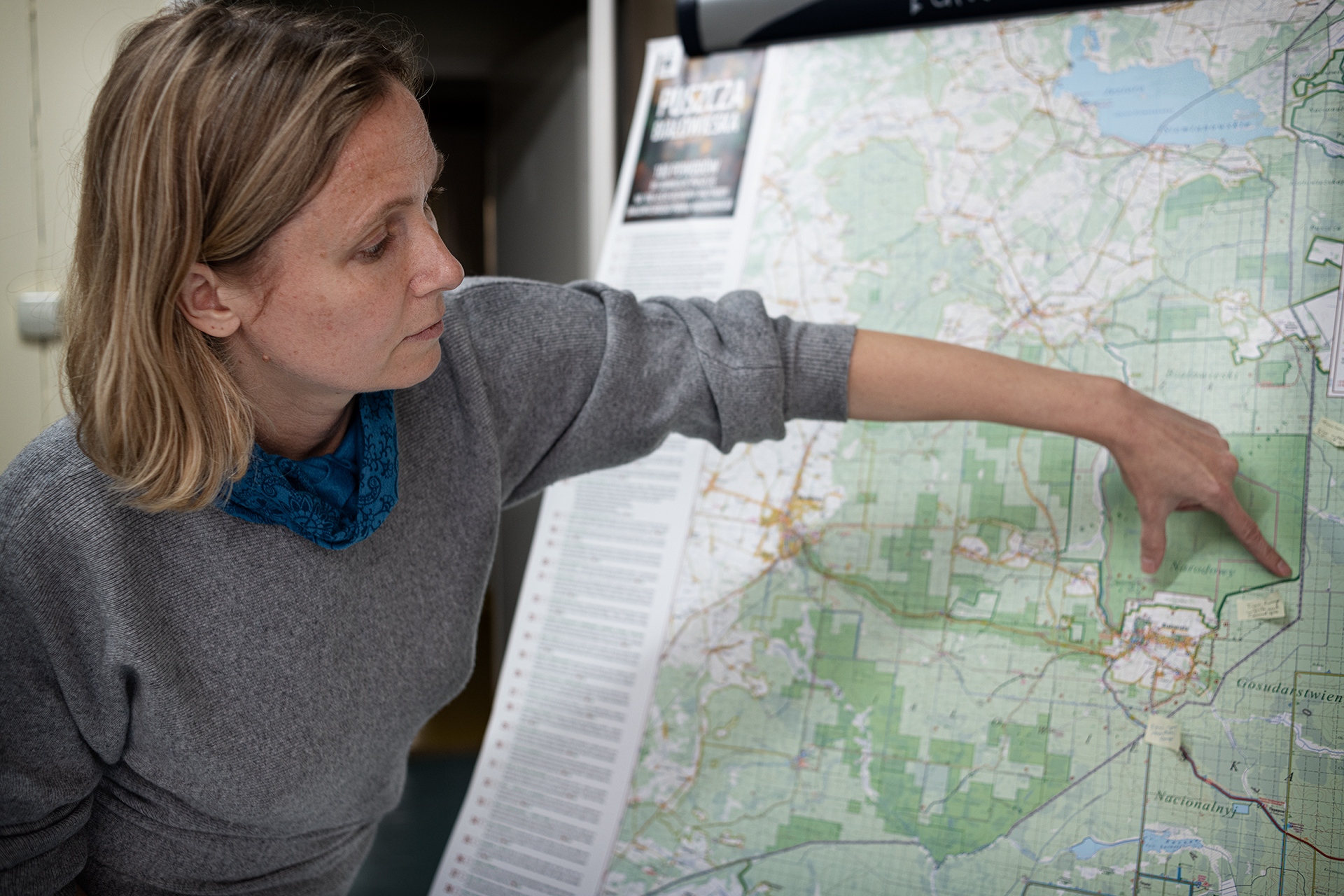
“From near the beginning of the crisis I was part of a small group led by Nuria Selva, writing letters to the European Commission and preparing a briefing about what was happening to this and other Natura 2000 sites along the Polish-Belarusian border. As part of this effort to write to the European Commission, I got in contact with people at the US-Mexico border. And this group also wrote a long detailed letter to the European Commission sharing their experiences. It was like a letter of warning. We hoped that it was going to prove to be influential in some way, to share these warnings of how the wall in the US-Mexico borderlands impacted not only nature, but Native people for whom the border is quite arbitrary there. In our case, the response from the European Commission was that they are waiting for the Polish authorities to get back to the commission about how they will mitigate the effects of this wall on wildlife and habitats. But from the government there was no environmental or social impact assessment and local authorities denied us research access so we might monitor what was going on.
Even though we are scientists, we could not access the border within 200 meters. We have tried to ask for permission to monitor potentially species of plants that might be new. And because we have noticed some potentially worrying plants in sand piles left by the construction company or a contractor of Budimex. But we were declined permission and the only explanation they gave us was to point to this rule according to which no one is allowed within 200 meters of the border. That's it. Still, we decided to monitor Browska Road and other, smaller forest roads nearby, as we knew Budimex was using some as technical and access roads.
Photo on the left (H.J): Katarzyna Nowak shows the Browska Road on Bialowieza Forest's map, Bialowieza, October 20, 2022
Photo on the left (H.J): Katarzyna Nowak shows the Browska Road on Bialowieza Forest's map, Bialowieza, October 20, 2022
Browska Road, which is about 5 kilometers long to the Polish Belarusian border, is a forest road that people use to walk, bike and ski in the winter. It has the National Park on the left and on the right, a state forest and animals go from one to the other across this road. So there's some wildlife movement from state forests into the park and vice versa by way of this road. It also is historically important. There is a memorial to victims of World War II, victims of fascism, where 222 people were killed in the vicinity or on this road. This road is also very old. Polish kings used it to get to Vilnius and royalty traveled through Browsk to Vilnius along this road. So it's one of the oldest roads still in use.
We decided to select this road as a kind of mini, environmental impact monitoring, concentrating specifically on wildlife mortality, and traffic monitoring. We put a camera trap, which is still there, to know how many vehicles are passing back and forth every day. Once we have started, we realized that roadside tree damage is also going to come into it.
If you have more than 120 trucks passing in a 24 hour period forest road which is about six meters wide, it becomes a 10 meters wide road. In this process of course a lot of trees along the roadside were damaged. As you can imagine, the impact was high. I kind of grouped the effects and decided to concentrate on direct effects, because there are indirect effects too. The effects are as follows: creation of side routes; roadside tree damage, which we didn't anticipate; leaving of various materials in the forest, some of which still remain and have not been cleaned up; and the wildlife road mortality.
We knew early on that Browska was going to be, unfortunately, one of those roads Budimex will use. It probably should have never been used as a technical route. But then we realized that Budimex also used Konski Tryb. It's a side road from Browska and particularly if they had a vehicle stuck on Browska, then they would come and use this route which is even a smaller forest road from Browska. They were also using other non-sanctioned routes in other parts of Puszcza Bialowieska and surrounds like near Masiewo. So we don't actually know how many kilometers of non-sanctioned routes Budimex ended up using.
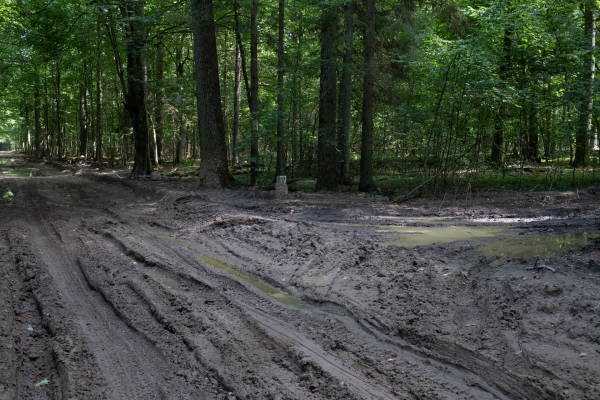
Photo (H.J): The Browska Road after being used by constructing trucks and army vehicles. August 20, 2022
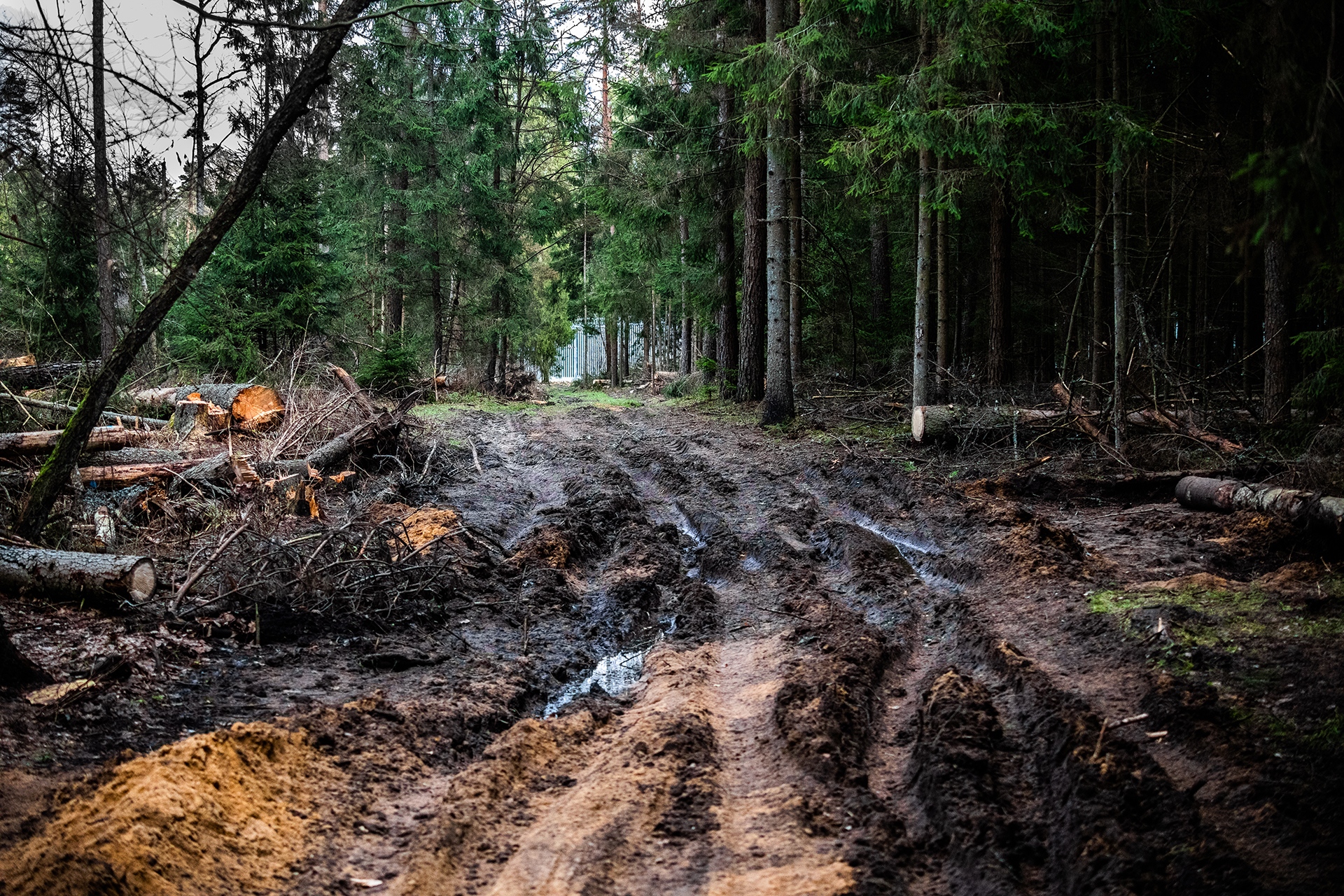
Much of the tree damage, we noticed as soon as we went for the first time in late February or March 2022. There were parts of the crown branches that had been hit. And also there were parts of the tree roots spread across the road. So a lot of damage to the root systems and we might not really see the consequences of this damage until the next few years.
There was no effort to protect roadside trees and protection of roadside trees is something that happens whenever you move heavy machinery along roads. You can see trees are wrapped or protected in some way in other parts of Poland and other parts of the world but not here in Bialowieza. With the exception of a road north of Wysokie Bagno which we dubbed the "show road", because that's where authorities or other visitors for inspections were brought to show them the work that was being done. This "show road" had about 30 - 35 trees protected with heavy wrapping. So on the show road, it was possible to do it. I mean, just a few kilometers away from Browska, and on Browska, they could have done the same and they didn't. They actually did do it on Browska for a couple of weeks in June for an inspection.
We counted more than 150 trees damaged, that's about 40 trees damaged per kilometer. But our students surveyed too and detected damage to more than 300 trees. The difference is because we were very conservative. If we didn't know to which tree a damaged root system belonged we didn't record the root damage, whereas our students were less conservative than us. So you can say that our measure is an underestimate of how many trees have been damaged along this road. Again, it's something that could have been prevented.
Photo on the left (E.K): Trees and road damage close to the border wall, The Bialowieza Forest, January 3, 2023
The road was widened and the shoulder was very high and some of the trees that were growing along the road were just frankly pushed over or fell over during the use of heavy machinery. Sometimes, the machines moved quite many meters off the road, too, and into the depth of the forest and also left various scrapes on tree trunks like the spruce, which can also get affected by insects or fungus. It's a wound just like a skin wound. It just looks quite brutal, like vandalism. Oaks were pushed over, we found broken hornbeams and all this sometimes it looked quite intentional, I mean they were widening parts of the road by intentionally knocking trees over.
After months of damaging trees, there was some kind of inspection and they wrapped the trees, even those with damage. They just wrapped it in a kind of quick way to show that the roadside trees were protected somehow, and it stayed like this for about a two week period. it was around the opening of the zone so maybe the inspection had to do with the pre opening of the closed area. This wrapping was removed and bagged up some time later. Now, on “show road” this protection was there all along. So it was possible to do at least some kind of preventative measures that were not taken in other places. And again, we speak about the World Heritage forest and Browska is a road that is also right adjacent to the National Park.
We also found a lot of materials that were left in the forest. There were cement trucks and cisterns that also drove this road. So we had a situation where a cement truck spilled cement nearly the whole length of the road. And then when the road was maintained or sand was brought, it was just all mixed together and obviously ended up on both sides on the state forest side and on the National Park side. There are still sand piles around. Some have species growing out of them that are not native to Poland or not even native to Europe.
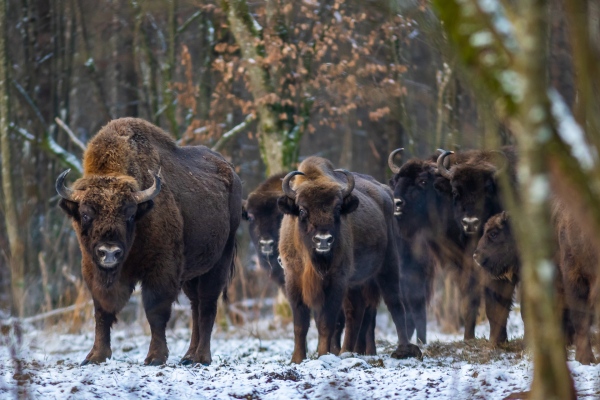
Photo (E.K): Bisons in the Bialowieza Forest, February 6, 2022
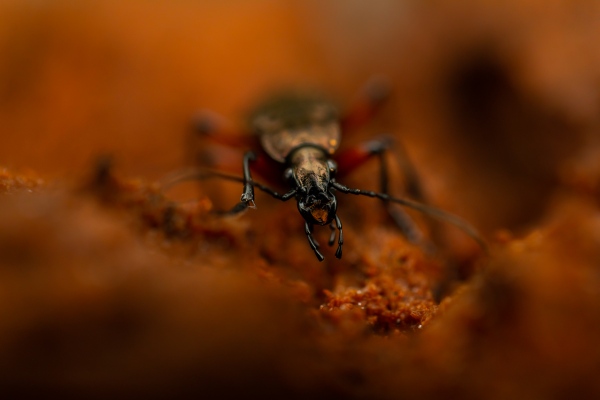
Photo above (E.K): November 28, 2020
Photo below (E.K): December 27, 2020
Photo below (E.K): December 27, 2020
We saw other materials like cans from engine oil and things that were thrown out of the trucks by the drivers of the trucks like plastic bottles, food wrapping, lots of cigarette butts, both from the military and from Budimex workers. People were even leaving feces and toilet paper in the forest without any kind of effort to dig a hole and bury this waste. We also found pieces of razor wire mixed in with some of the sand and gravel. We were picking up pieces of razor wire almost on every monitoring visit. Obviously it is dangerous for animals that are using this road.
We would notice that there were kinds of rainbow puddles along Browska road as well, coming from cisterns. There were also these kinds of trenches that were dug to drain all the standing water accumulated on Browska Road after rain. If you think about all of what was being deposited on this road, you can imagine that this runoff is not just rainwater with mud, it's rainwater with everything that was getting spilled here: the sand from wherever it came, the cement and so on. And the water is just draining into the park with all of this material.
Finally we have the road mortality, which was our original monitoring goal. They were building during the spring migration and there were amphibians, reptiles too on this road moving. So we knew that there would be some mortality and we wanted to count this. It turned out that we have more than 150 animal victims, such as: small mammals and even birds, thrushes, of course, amphibians and reptiles are the most frequently hit on this road and that includes grass snake, Anguis, slow worms were also run over, frogs and toads. We stopped counting insects because there were so many hundreds of beetles killed that it was impossible for us to write down every crushed beetle. So what we ended up doing is we've just made a list that now includes more than 20 species of insects that were also being killed just to at least have a list of the species affected.
Another thing we have noticed was that animals were appearing on our camera traps early in the morning or at night, probably avoiding the traffic of the day. We had deer and boar, fox, wolf, bison appear on the camera traps again, usually at night. So there was certainly some effect to their activity patterns, likely because of what was occurring along this road. Also we did not notice any kind of speed enforcement, any kind of speed limits.
Before they started the construction, there were no consultation meetings. Well, that depends also on who you ask. If you ask Budimex, they will say, yes, there was consultation. If you ask, say the director of the Mammal Research Institute, he would not necessarily call this a consultation. There was nothing put into writing. It was an informal discussion that was held and there's no evidence that scientists' recommendations were put into practice or were taken on board. So if you speak about consultations, it really depends how one defines consultation. And consultation does not mean consent, nor does it mean that you agree with this kind of wall going up.
What they should have done is to implement a mitigation hierarchy at least, and this is something that has several steps. The first one is to avoid damage in the first place. So in the case of Poland's border wall, they could have avoided any cutting in old growth. And this was not something that was done. Another thing that could have been implemented is to restrict any kind of activity at night. Also not done because we have camera trap photos of the Budimex vehicles onBrowska road at night as well. Not to mention the military active at all hours along, but also sometimes in very big, heavy machinery. Both rivers Narewka and Hwozna have a structure over them and we don't actually know how deep this structure goes, and this too, rivers, could have been left alone.
The next step would be to support independent monitoring by scientists. It was not done. You could reduce light and noise. This was not done and we might still see further light and noise in the maintenance of this wall. You could restore the vegetation cover now along the border, but nobody is asking the Geobotanical Station about possibly advising on restoring vegetation along this area.
You could support radio telemetry by the Mammal Research Institute as a way to know how animals are responding to this wall, to know how wolves, moose or lynx might change their behavior. All of this is a concern in terms of genetic diversity. Are we going to have to invest in some kind of assisted migration so that we maintain gene flow between both sides? Wildlife has lost more than half of its habitat through this wall. Is there any kind of offsetting some kind of establishment of new nature reserves or an expansion of the national park? That might be a way to compensate for that habitat loss. No discussion about that. So, you know, consultation means you follow something like the mitigation hierarchy. There are established ways of doing environmental impact assessment and conducting a consultation. So the fact that somebody from Budimex, went and had one or two conversations with one institute in Bialowieza, because nobody ever came to talk to us, I would not call this a consultation.
There's no kind of environmental review at all. We tried to do a kind of mini social impact assessment, something that we are not versed in, but we had advice from sociologists, psychologists and others, and we created a survey and we carried out some interviews. We had 100 respondents and we are entering and processing those data now on how the situation was perceived, how people were impacted, how their use of the forest was altered by what was occurring and by the state of emergency, followed by this closed zone because that was a ten month period. So if you talk about a real social impact assessment or social consultation, then you can also say that it didn't take place with the large number of communities living in the borderlands.
Another problem is related to gates. First of all, those gates are now closed. So animals are not learning about potentially open areas. Probably they are trying to move and walk just along the perimeter of this barrier, and therefore they are just learning that this is a linear structure that does not have any kind of gap. Secondly, even when those gates are opened, from my understanding, they won't be open all the time. They will need to be monitored remotely or otherwise, because if a moose or a bison can cross, then a human can cross too. And therefore that contradicts the supposed purpose of this barrier to block people.
Third comment is we know there is the systema on the Belarus side (read below the interview with Rafal Kowalczyk) that is also a barrier for some, not all, animals. Some animals can get over the systema, but it does mean that animals might get, at least for a time, trapped in these pockets of habitat between one barrier and the next. And the effects of these two barriers are cumulative.And my final comment is that there are gaps along the US-Mexico border wall that were anticipated to be these ecological tunnels for species moving from one side of the border to the other. These gaps are not necessarily used and researchers have been permitted to use camera traps there to monitor wildlife. So they know that there have been declines in wildlife, even in those gaps. And so just because there is a gap doesn't mean that an animal is going to use it given the wider landscape. So knowing that about gaps elsewhere, the same can be said about gates in the polish wall.
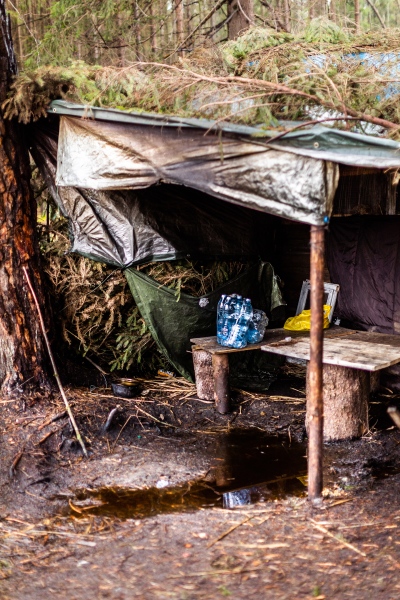
Photo (E.K.): A military post built in the middle of the Bialowieza Forest, January 16, 2023
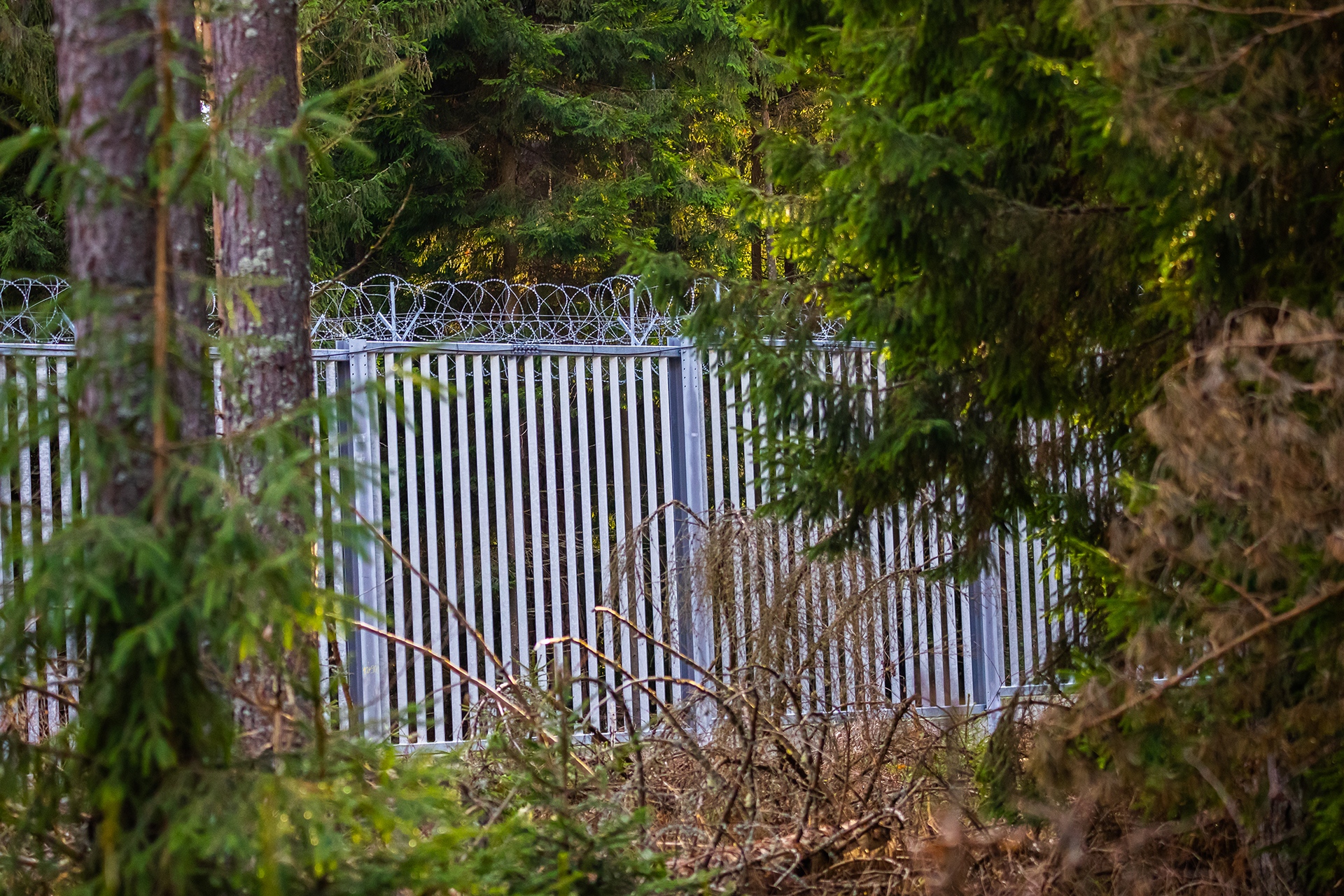
I don't think that there was any effort when it comes to ways of considering how the impact of the wall might be mitigated at the environment or human communities level. I was mentioning the US-Mexico border. It is true that the environmental context at the US border wall is different than here, but still one could compare both situations, draw basic conclusions and prepare better for the wall’s construction here. One researcher in Montreal, Elisabeth Vallet, who works on border walls, says: "walls are a good way to do nothing while looking like you're doing something". They took inspiration from that and said, let's build our own barrier. Even when the evidence shows time and time again that walls do not deter people, that walls increase the probability of human trafficking or the use of more dangerous routes.
I think it's not only an abomination to the Bialowieza Forest, which is this crown jewel of Poland and Europe and the world. The European Commission has now turned a complete blind eye to the situation which shows to me that they accept this wall on the eastern border of the European Union. We should talk about this wall as not Poland's wall, but the European Union’s wall, really.
I have always been really excited by the potential for trans boundary areas and conservation as a kind of diplomatic tool also, even in Belarus, where many people are really having a hard time and many are imprisoned. Before there was some kind of collaboration, the scientists from here used to go across the border and see particular trees or they used to talk to someone. I guess now there is a complete pause or a dearth in any kind of communication or collaboration with the Belarusian side and I'm sure that if you talked with some people in the National Park for example, they would say they were missing that contact. Also when you think this place is a UNESCO's World Heritage, you can be really excited about coming here where you have this amazing old growth forest that still remains and it's very sad to see it brutalized or disrespected in the way that it has with the construction of this wall.
Photo on the left (E.K): The border wall in the Bialowieza Forest, January 3, 2023
From a human perspective, I never thought that my country, who has also experienced asylum seeking and the Polish diaspora spread all across the world: everywhere I I've gone in my life, I've met Poles, whether it's South Africa or Canada or wherever, well I never thought that we would behave in this way towards people running away from a bad situation. So it's very hard to accept.
I came here for the first time in October 2021, so I'm very new here. Just at the beginning, I think this was my second time ever in the Bialowieza Forest. I was with someone from the station collecting fungi and we had parked the car, which had Warsaw plates. Suddenly we saw a group of people, just ten people running away through the forest. And behind them were soldiers. And we happened to be in this place at the same time. And so the soldiers approached us with their faces covered on, with their weapons partly raised thinking we were helping this group of refugees who were running away, especially since our car was just parked right here. And so we had to put our hands up and then they marcheed us over to the vehicle and we showed our papers and explained that we were there to collect fungi, which sounded ridiculous probably at the time. In the middle of October 2021 when there were 16,000 attempted crossings and we were collecting mushrooms… The soldiers let us go and when our car passed later on, some of the people in that group that were running away were now sitting on the side of the road. The military had taken them into custody. There was one woman with a small baby there and I remember making eye contact with her. I'll never forget that moment of seeing this young woman clutching her baby on the side of the road. Since then I carry water in my bag in case I meet somebody. I'm also connected with some of the people who bring help and I've participated in that a few times.
I didn't know the forest before this situation. I guess for people who know the forest for many years, like my boss who has been here for 30 years, the contrast is probably a lot more stark. For me, the forest has always been filled with people since it's just been a year that I've been here. But it doesn't make it any easier.” - Katarzyna Nowak
Read also: "Poland's border wall threatens ancient forest."
authors: Katarzyn Nowak and Bogdan Jaroszewicz, Faculty of Biology, University of Warsaw, Bialowieza Geobotanical Station
authors: Katarzyn Nowak and Bogdan Jaroszewicz, Faculty of Biology, University of Warsaw, Bialowieza Geobotanical Station
Interview with Rafal Kowalczyk,
former director of the
Mammal Research Institute of the Polish Academy of Sciences
Photos and text: Eliza Kowalczyk
Eliza Kowalczyk: In the second half of 2021, a migration crisis erupted on the Polish-Belarusian border. Refugees and migrants from numerous war-torn, conflict-ridden, and famine-stricken countries in the Middle East, Asia and Africa were enticed to Belarus by the Lukashenka regime with the promise of expedited passage to the European Union. Consequently, there was a significant surge in the number of people crossing the border. Spanning 418 kilometers in length, the Polish-Belarusian border traverses 55 kilometers through the ecologically significant Białowieża Forest, a Natura 2000 area and a UNESCO World Heritage site. The border runs alongside the eastern perimeter of the Białowieża National Park.
To address the migration crisis, the Polish government swiftly opted to construct a barrier using concertina-type razor wire along the border. How did the scientific community, focused on studying the nature of the Białowieża Forest, respond to this development?
Rafał Kowalczyk: The use of razor wire has sparked controversy worldwide due to its lethal impact on both animals and humans. It has been described as a “brutal approach to border protection.” As a result, the scientific community and environmental organizations have voiced strong opposition, citing the significant threat it poses to various animal species, including protected ones like wolves, lynxes, and European bison. These fences not only act as barriers to animal migration but also become deadly traps, particularly when placed along the banks of border rivers. Our institute has been called upon twice to rescue a deer and an elk entangled in the wire. Animals easily get caught in the sharp edges of the razor wire, resulting in cuts to their skin, muscles, tendons and blood vessels. In their desperate attempts to free themselves, the animals struggle, further exacerbating their injuries. Ultimately, these animals perish in agonizing pain.
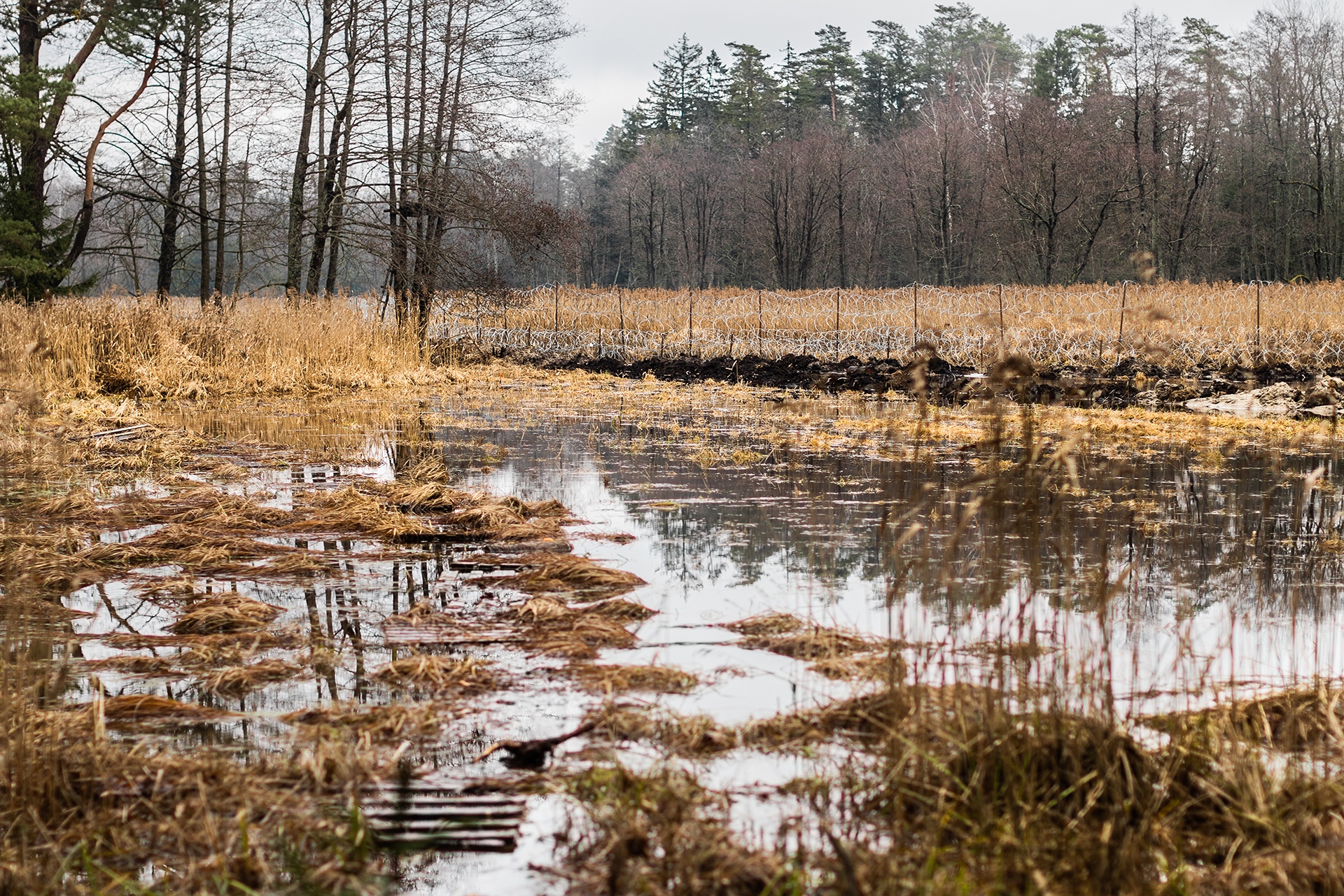
E.K.: It became evident that such a dam was ineffective, leading to the decision of constructing a 5.5-meter high steel wall. This decision generated significant controversy and encountered opposition. Protests were organized, appeals were written, but despite the resistance, the wall was ultimately erected and stood in place.
R.K.: As soon as the idea of erecting razor wire fences and later a wall along the border emerged, we raised concerns about the impact on animals. Barriers pose one of the most significant threats to nature. In October 2021, the Scientific Council of the Mammal Research Institute of the Polish Academy of Sciences released its position on the border crisis with Belarus and the construction of a border fence. The position highlighted the irreversible consequences of building a barrier for the nature of northeastern Poland, particularly the unique ecosystem of the Białowieża Forest. In November, three scientists from the Białowieża Geobotanical Station of the University of Warsaw and IBS PAN published a letter in the scientific journal "Science", drawing attention to the risks associated with constructing a dam in the Białowieża Forest and the Białowieża National Park, which have been protected for a century,, and the species inhabiting these areas. The scientific community also addressed the European Commission through a letter signed by over 1 800 scientists worldwide regarding the construction of the wall on the Polish-Belarusian border. The letter called for an immediate halt to the construction until it complies with EU law and environmental protection requirements, assessing its impact on the Natura 2000 network’s coherence. THe letter emphasized the need to design the project to minimize adverse effects on valuable species and natural habitats. Additionally, the Climate Council of the Jagiellonian University expressed its opposition to the wall’s construction, highlighting that it fails to address the long-term issue of climate refugees and pose a threat to biodiversity while incurring significant economic costs. Unfortunately, these appeals were left unanswered. Proceeding rapidly, the act on the construction was passed in early November. The plan encompassed a 186 km stretch of the border from the Bug Valley to the Kuźnica Białostocka border crossing. The dam’s estimated costs amounted to PLN 1.6 billion, and construction commenced at the end of January 2022.
E.K.: The Regional Director for Environmental Protection in Białystok, in collaboration with the General Director and other environmental services, conducted an analysis of the investment's impact on all Natura 2000 areas. According to their findings, it was concluded that the barrier would not have a detrimental effect on the environment. However, is this truly the case?
R.K.: The construction of the dam itself, which lasted several months, poses a threat to habitats and species, not just the presence of the dam itself. The use of heavy machinery, increased traffic, and the creation of access roads along the border result in environment pollution with noise and light, leading to disturbance in animal activity and causing them to be frightened. It is especially concerning since the construction began at the end of winter, coincig¡ding with the breeding season for various animal species inhabiting these valuable natural areas, not just birds. The transportation of aggregate from outside the Forest and the increased traffic also elevate the risk of introducing and spreading invasive plant species. Our monitoring efforts, using camera traps, revealed that large predators practically ceased using the 2 km strip along the border due to the heightened activity from the border guards, the military, and the dam’s construction. Hence, there are numerous risks involved. Two months prior to the construction commencement, the Mammal Research Institute of the Polish Academy of Sciences proposed measures to mitigate the dam’s negative impact on habitats and species. These measures included avoiding construction in swampy areas and river valleys and incorporating openings with a minimum diameter of 20 cm in the dam spans to facilitate the passage of smaller animals. However, only the suggested openings at the base of the wall were considered, and they have a diameter of only 10 cm. This means that they can only be utilized by small mammals, amphibians and reptiles. Many of these openings were buried during the construction process, while others are positioned too high above the ground and will likely become obstructed by dry leaves and twigs. Yet, the Ministry of Climate and Environment mentions an impressive figure of over 74 000 openings, aiming to create an impression of mitigating the dam’s effects.
E.K.: Will the border fence cause harm to animals, or has it already done so? Are there gates in the dam at regular intervals for animal passages? Does this system effectively function, and as scientists, do you have means to monitor its effectiveness?
R.K.: Unfortunately, I fear that these gates, which are more like access points for services to cross the barrier, will remain closed, at least for the duration of the migration crisis. The effectiveness of the planned mitigation measures will largely depend on whether, when, and for how long the designated dam gates will be opened. Animals learn to navigate barriers through specific openings or migration corridors. If these openings are closed for extended periods or only sporadically opened, it will cause confusion among the animals, potentially leading to them not using them at all. The gates will also serve as narrow entrances to enclaves that can span several kilometers in length and up to 2 km in width, situated between the dam and the Belarusian system. If the passages are closed, animals can become trapped in these enclaves. Similar situations occurred in the Białowieża Forest before the dam’s construction, when razor wire fences were placed along the border. Groups of European bison, using these areas during the summer and returning to feed grounds in the central part of the Forest, became trapped in the enclaves between the border and the system. As a result, two bison died, and it took several weeks to release the remaining ones, despite initial assurances from the Ministry of Climate and Environment and the Białowieża National Park, responsible for bison, that no bison were behind the barbed wire.The fence itself acts as a barrier that fragments the environment and disrupts animal populations, hindering their movement, migration, and gene flow. This is particularly concerning as the Białowieża Forest serves as an important corridor connecting the east and west of Europe in both directions. The dam effectively separates populations into isolated groups on either side of the barrier. Consequently, this disruption will lead to disturbances in spatial and social structures, gene flow, and ultimately in a reduction in population size, reproductive opportunities, access to food, and genetic differentiation. This is especially significant for species like the lynx, which we have been studying for over 30 years. The Białowieża Forest is a cross-border UNESCO World Heritage Site, and it has always functioned as a cohesive ecosystem.
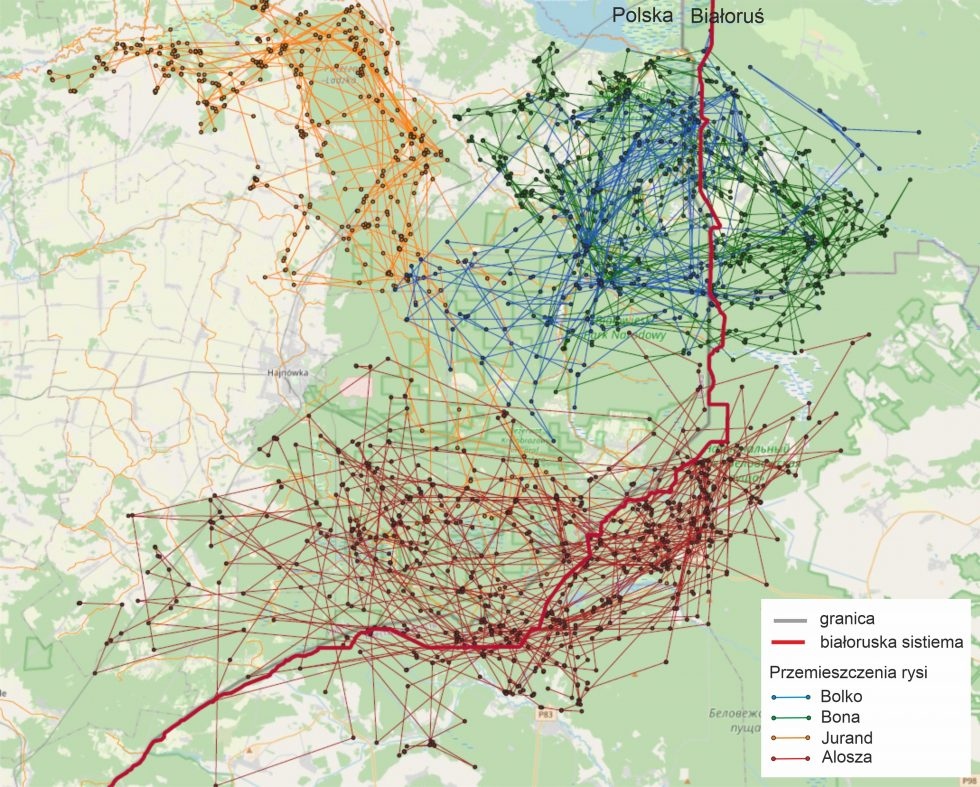
Image above: Migration of lynxes, source: Institute of Mammal Biology of the Polish Academy of Sciences
E.K.: How does the dam harm lynxes?
R.K.: The lynx population will be divided, leading to significant reduction in the number of lynxes on both sides of the border. Previous research has shown that approximately 30-35 individuals inhabited the Bialowieza Forest. With the construction of the dam, there will only be a dozen individuals on each side, including a few breeding females. This is a remarkably small number. The northeastern part of Poland is a crucial area for this species, with around 65 individuals, accounting for nearly a quarter of the entire Polish lynx population. Despite ongoing protection efforts spanning nearly 30 years, the lynx has struggled to expand its range within Poland. The current population stands at approximately 200 individuals, and their distribution remains limited. Now, this already small population will face further division due to the border fence. In Poland, lynxes cannot migrate westward due to the presence of large open areas that they typically avoid. Research conducted in the 1990s and 2000s indicated that a significant portion of the lynxes we tracked had territories spanning both sides of the border. Consequently, the fence will cause significant disruption to the spatial organization, social structure, movement, and migration of lynxes, as well as their ability to find food and reproduce. Individuals that previously had territories on both sides of the border will suddenly find themselves stripped of part of their territory.
E.K.: What is the situation with wolves?
R.K.: Telemetry studies conducted in the 1990s revealed that wolves were capable of crossing the Belarusian system. Some argue that this research is outdated due to modernization of the system. However, after reviewing the matter and consulting with our Belarusian colleagues, it appears that the system remains largely unchanged. The modernization efforts primarily focused on constructing bridges over rivers, while the overall course of the system remained intact. In recent years wolves on the Belarusian side of the Forest have been collared and monitored. These collared wolves have been observed crossing the border. However, it is worth noting that wolves exhibit less frequent border crossing compared to lynxes. This behavior aligns with the spatial organization of wolves within the Białowieża Forest, as the border also serves as boundary for their territories.
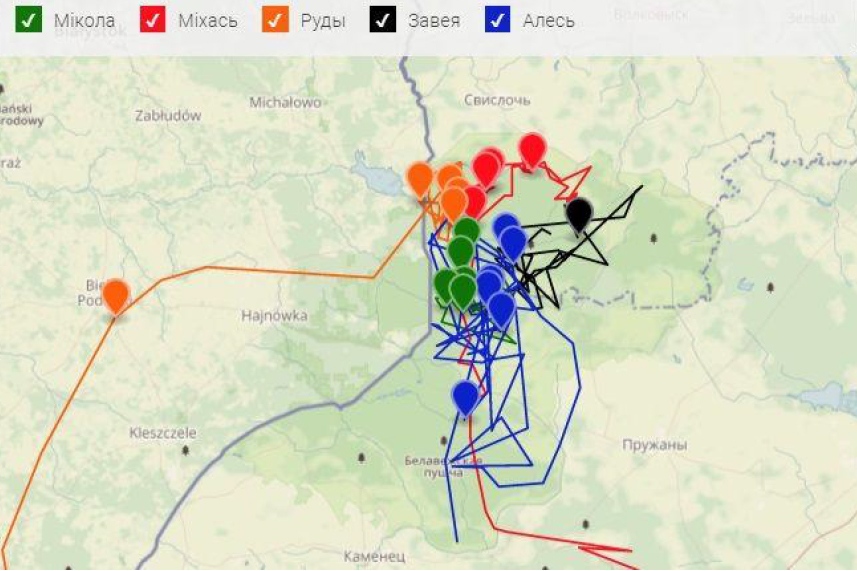
Image above: Source: Frankfurt Zoological Society
E.K.: Brown bears were indeed extinct in the Białowieża Forest by the end of the 19th century, with the last known individual being killed approximately 140 years ago (in 1879). However, in the last 4 years, there have been observations of a brown bear individual on both the Belarusian and Polish sides of the forest. The question arises whether bear migration is now possible with the presence of the dam?
R.K.: In the past three years, there have been several observations and traces indicating the presence of a bear on both sides of the border. It appears that this bear has already established its presence in the area, potentially signaling the beginning of a population and the return of bears to the Bialowieza Forest. Previously, the closest population to us was located in Belarus, approximately 400 km away from the border in the Berezin Biosphere Reserve. However, in recent years, bears have been observed in the Nalibocka Forest, which is already 200 km from Poland. Initially, there were individual males, and later females also appeared. It is possible that the next stage of recolonization is the Białowieża Forest. Recently, there was a sighting of a bear near Kuźnica Białostocka, which is situated in the northern part of the Knyszyn Forest, several dozen kilometers away from the Białowieża Forest. All these observations suggest the settlement of these large predators in northeastern Poland could be expected in the near future. Unfortunately, the border barrier will hinder this process.The last sighting of the Białowieża bear was in July 2022 from the Belarusian part of the Forest. This news carries both negative and positive aspects. It is unfortunate because it suggests that the bear is unlikely to appear on the Polish side of the border. However, it is also good news because it indicates that the bear has not been completely isolated from other bears in Belarus.
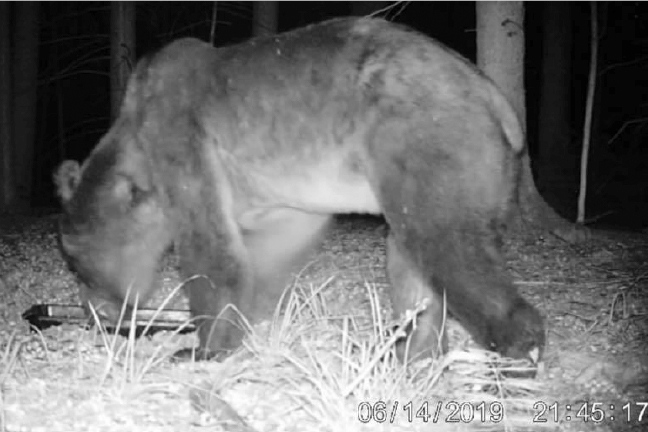
Image above: Source IBS PAN
E.K.: Does the situation at the border, including the barrier, the presence of a large number of troops, and the restrictions on movement in the border area, have any impact on scientific work?
R.K.: As scientists, we are aware of the negative impact that barriers have on nature based on research conducted in other areas. Importantly, border fences do not solve the migration crises, as we can unfortunately observe on the Polish border, where refugees still attempt to cross the border fences using various methods. The turmoil at the border has indeed hindered our scientific work and collaborations. In Białowieża, we used to organize meetings, scientific internships, seminars and conferences, and other events. However, these activities became impossible during the closure of the border zone. Even when the Forest was finally reopened, a ban on staying in the 200-meter zone along the border was implemented. This posed challenges for us as our research areas are located within that zone where we monitor various mammals species. Despite our efforts, we faced difficulties in obtaining permission from the Podlaskie Border Guard Unit to access these areas, and we were constantly subjected to certain conditions when granted permission. Moreover, we could not remain indifferent to the migration crisis unfolding at the border. Many of us have been involved in assisting refugees. These experiences have left a lasting impact on our psyche. We are familiar with this forest, and we understand the challenging terrain it presents for people coming from different climatic zones and environments. People die here. We still come across traces of the presence of refugees, and it deeply saddens us that this unique forest has become a site of such dramatic events.
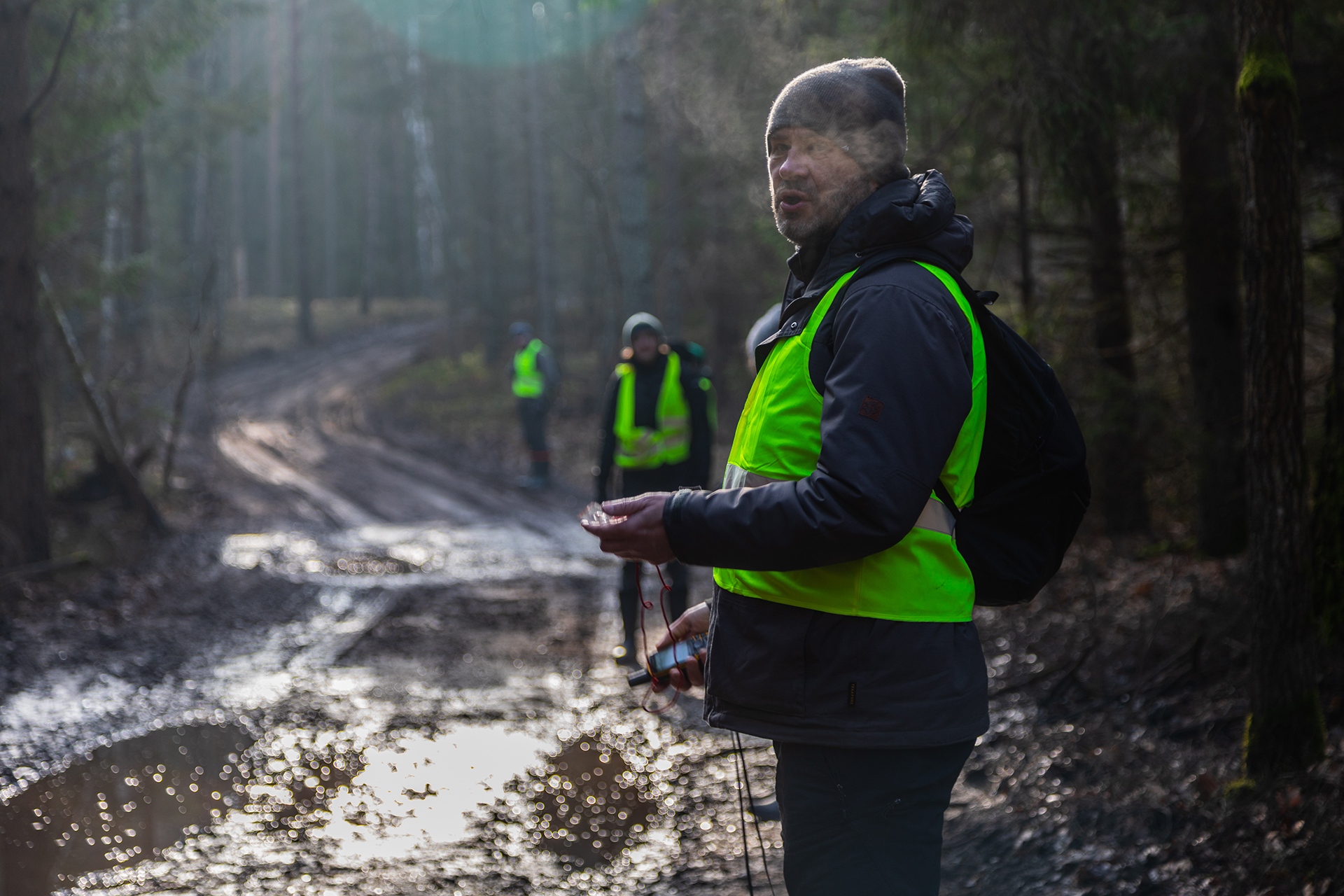
Photo above: Rafal Kowalczyk, February 16, 2023